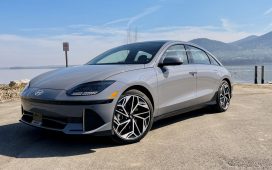Fisker released new images of its optimistically priced Pear electric crossover, including footage of its so-called “Houdini trunk” in action. And as far as automotive gimmicks go, this is a pretty good one.
Henrik Fisker has been talking about the Houdini trunk for a while now, but this is my first time seeing it in action. With the touch of a button, the rear window rolls down into the hatch — and then the entire door disappears into the underbody of the vehicle. It just rolls down like the window.
I’ve watched this video a couple of times now, and without seeing it in real life, it’s hard to say how exactly this feat is achieved. Like, how does the entire trunk fit within the bumper? Fisker showed it off during the company’s Vision Day presentation earlier this month, and the onstage demo definitely seemed a lot slower than in this produced video. Fisker said the slower speed was “to allow the feature to be captured on video,” while “the production version will move at high speed up and down.”
Fisker said it designed the trunk for maximum flexibility with young urban dwellers in mind. When you’re parallel parking on a crowded city street, for example, you don’t want to worry about the trunk swinging open into someone else’s bumper — or cracking you in the head, for that matter.
The Houdini door isn’t the Pear’s only gimmick. There’s also a drawer-like front boot, or “froot.” (Get it? Froot? Pear? Zing!) Fisker says the froot is perfect for storing anything from delivery pizza to sweaty workout gear, thereby keeping odors out of the cabin. And the front row of seats eschews a center console in favor of a bench seat to add an extra passenger, thus making the Pear a rare six-seater compact SUV.
All of this points to what Tim Stevens has dubbed the era of weird cars: the trend of automakers dressing up their new electric vehicles in a variety of off-beat designs and features in order to signal a break from the automotive past. These include crystal ball shifters, self-balancing suspension, crab walks, and a whole galaxy of technicolor LED palettes. Add Fisker’s disappearing-reappearing trunk to the mix of funky EV features.
The new images of the Pear reveal it to be as quirky on the inside as it is on the outside. The design language appears to lean heavily on what I would call “adorable automotive,” with lots of grabby blue material, rounded edges, and other aspects aimed at appealing to young urban professionals.
Whether we’ll get to see the Pear in the flesh will depend on Fisker’s ability to improve the production and delivery cadence of its first EV, the Ocean SUV. The company produced 1,022 Oceans in the second quarter of 2023, less than the 1,400–1,700 vehicles it had expected to make. Revenue was just $825,000, while operational losses amounted to $87.9 million, including $9 million of stock-based compensation expense.
The company says it expects to produce 20,000–23,000 vehicles for the year. The Pear isn’t expected to go into production until at least July 2025.











